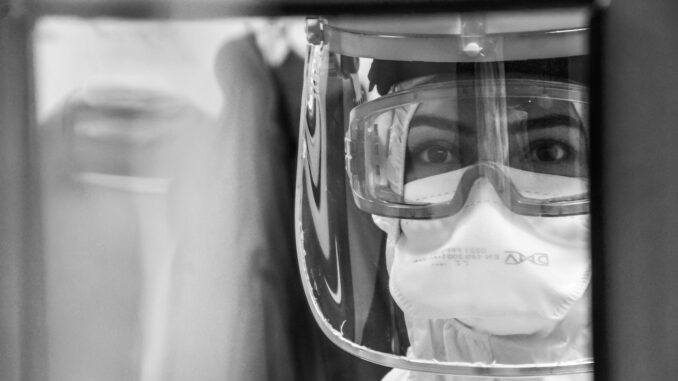
Long before the pandemic, the Healthcare industry was on its way toward becoming high–tech. Virtual health delivery is one of the major challenges in front of the healthcare industry. Due to this medical practitioner requires a new approach to handle the current issues, and the answer may come from an unexpected source: augmented reality smart medical goggles.
Contents
Demand for Smart Medical Goggles to Increase in The Near Future
Medical goggles, also known as medical safety goggles or medical protection goggles are utilized by doctors, medical technicians, nurses, and other healthcare workers to keep liquids and aerosols out of their eyes. Medical goggles are a sensible choice for healthcare workers because they are vital for frontline employees and are primarily used to protect the eyes from hazardous viruses and toxins. However, as technology advances in medical goggles, they serve for much more than mere eye protection for healthcare providers.
As technology is continually advancing in the medical industry, medical goggles appear to be a viable way to improve healthcare solutions. The implementation of severe government laws managing the safety of healthcare staff is a major driving factor in the global medical goggle market. Furthermore, increased demand for medical goggles in the healthcare sector, owing to the rapid spread of the infectious coronavirus, propels the market forward. According to Allied Market Research, the global medical goggles market is anticipated to grow at a significant CAGR of 8.8% from 2021 to 2030. Growing research and development initiatives, as well as advancements in medical protective goggles, are likely to generate promising opportunities for the global market to expand throughout the forecast period.
Recent partnerships and advancements in smart medical goggles
With the rapid penetration of technology and the growing advancements in the medical industry; the medical goggles seem promising for enhanced healthcare offerings. Market players are investing in numerous research and development activities to allow physicians to guide through medical procedures employing advanced technology. A company in the aerospace and defense industry is developing a device that will provide authentic, hands-free assistance for 50 diverse medical operations. This will help to improve medic proficiency and lower treatment errors in difficult circumstances like battlefields. Though originally intended for military use, such technology might readily be adapted for use by surgeons, first responders, and other healthcare professionals.
The team will collect over 2,500 video clips of battlefield medical data sets captured in stereo to give 3D data to train the AI and 50 million photographs are used to determine the specific sequence of procedures using AR goggles of the task guidance program of DARPA. The AR goggles’ built-in cameras monitor the user’s behaviors, utilizing AI to correct them either on-demand or when intervention is required, such as follow-on actions or metrics like elapsed time or dose, via audio suggestions or visual overlays in the headset.
In the hands of medical specialists, augmented reality has shown to be a powerful tool. Market players are adopting strategic partnerships to test the applications of smart medical glasses with AR technology. Vet Clinic has teamed with a veterinary services platform based in Cambridge, United Kingdom, on a pilot program showcasing the functional use-cases of AR technology in the veterinarian clinic. A clinical team from Pennard veterinarians’ clinic in Sevenoaks used a pair of Google Glass Enterprise Edition 2 smart glasses and was able to transmit video and audio to a group of Vet CT specialists tuning in virtually from Kent, London.
Specialists could capture photographs and video in real-time and also provide crucial feedback to the wearer. The built-in speakers and microphone of this device might also be used to communicate back to professionals. Veterinarians can connect with specialists using Google Glass while keeping their hands accessible to operate. The technology can also broadcast necessary details onto the real-world situation for the wearer to reference.
Covid-19 impact-
Covid-19 has caused huge disruptions in healthcare workflows around the world. Several industries, including multiple subdomains of healthcare, have been forced to temporarily halt operations due to the pandemic. However, as the number of cases of Covid-19 has escalated, this, in turn, improved the demand for medical goggles. This is specifically owing to the enforcement of strict government rules requiring the use of protective eyewear when working in sensitive situations.
Workers in healthcare environments are particularly vulnerable to Covid-19 infection, especially when there is a risk of fast droplet dispersion while working with patients who are coughing or using a high-flow nasal cannula. As a result, numerous organizations, including the WHO and the CDC, suggested that all healthcare personnel should wear goggles when caring for Covid-19 patients. As a result, the COVID-19 outbreak has had a favorable impact on the medical goggle industry. Moreover, the advancements in smart medical goggles are expected to aid the market growth in the coming years.
Author’s bio:
Vaishanavi Kumbalwar is a fun-loving, independent, unconventional and original thinker who loves to put her thoughts into words. She holds a bachelor’s degree in Mechanical Engineering and currently working as Senior Associate Content Writer at Allied Market Research. She thrives on challenges and loves to explore different writing styles to bring off her fondness for being a writer and blogger. She is an enthusiast of different cultures, places and cuisines and loves to travel off the tourist path and explore new things.
Leave a Reply